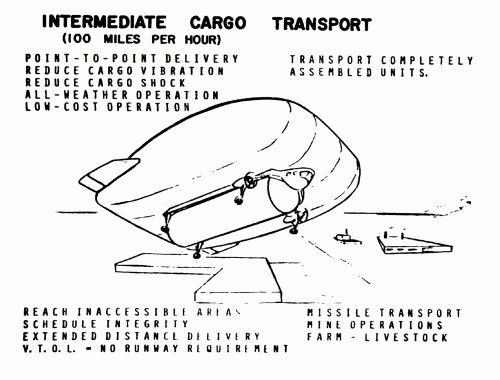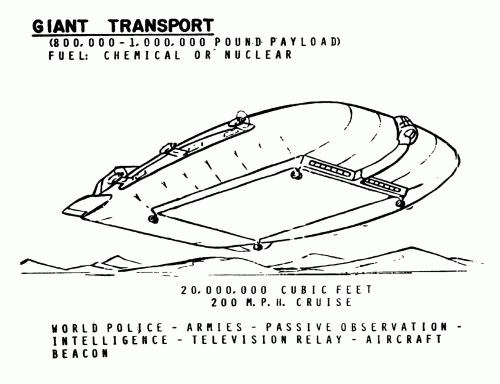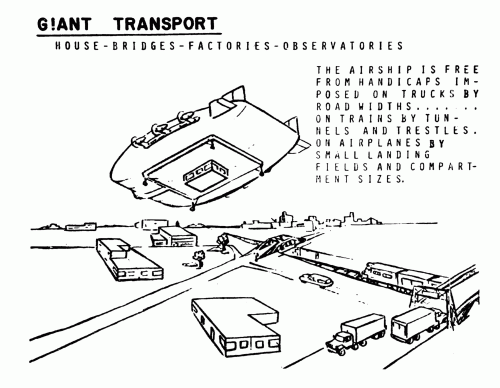- Joined
- 25 June 2009
- Messages
- 14,754
- Reaction score
- 6,155
At some point during the late 1960s, the Goodyear company studied the possibility of a new giant rectangular transport airship category which they called "Dynastat".
Source: AERIAL VERY HEAVY LIFT CONCEPTS FOR THE 1990 ARMY VOLUME III - ACADEMIC & INDUSTRIAL PRESENTATIONS (U.S. Army, November 1969)
We found out that a normal, single-hull balloon that could lift about a ton statically, would give 200 pounds extra in dynamic lift.
By taking this configuration and giving it some shape, operating it about 30 miles an hour, we were able to get not 10% in dynamic lift but 500%. In other words, this balloon that would normally lift a ton would now lift five tons. You can readily visualize if you are going to pick up logs and take them out of the forest, you would change the payload from 2,200 pounds to 10,000 pounds. If you examine the economics of it, at the end of the day it is how many pounds of logs you have at the landing that determines your effectiveness.
So, the dynamic lift becomes a very important factor. By shaping the airship a little differently you can now start getting a larger dynamic lift, but what does it do to the ground
handling? If this vehicle is flying heavy then when you come in and land you are not subject to the vagaries of the wind. You are going to set where you come down. The heavier you make it the less apt you are to move so if you take-off vertically you can do that by the function of the amount of power you have. The gas then actually supports the bare structure and you might say that you are going to carry the payload with your dynamic lift. If you considered this a helicopter, all you are saying is that the helicopter doesn't
weigh anything. You are balancing off the empty weight and you are just carrying your payloads with the rotor so when you look at the horsepower required it is, naturally, considerably less. The percent of heaviness you carry, 25% or 80% is up to you. What we were showing is that there is no need for heavy-duty runways, or expensive airports.
This vehicle is very much like the helicopter. Actually the buoyancy of the gas is used to support the structure so you have a structure with zero weight. It is hard to beat that.
This ship has a new name. We call this a "DYNASTAT" instead of airship. In some places the word airship doesn't go over too well, so we take an Aerostat and mix it with dynamic lift and come up with a "DYNASTAT". Now, everybody can look at that because it's new and feasible. You can select the lift that a "DYNASTAT" should have and determine the size it would be. You remember in the conventional airship, these lines were fairly flat, but now you are starting to get some of this square cube law and you begin to see a little bit of an effect of range. When you talk about a low range you can see that you get substantial lift. It doesn't take a lot of speed to do it either.
Now, let's talk about safety. Visualize the "DYNASTAT" with some percent heaviness and say that you had a complete power failure. If you are already in forward motion, you can glide to a flared landing. If you are hovering, you are in the parachute range, as far as wing loading is concerned. Just look at the vehicle - the size of it, and the amount of overweight and you find that you have a loading that is very similar to parachutes so you are actually descending at a parachute rate. In other words, you aren't catastrophic.
It is almost impossible to be catastrophic in this kind of a vehicle.
Source: AERIAL VERY HEAVY LIFT CONCEPTS FOR THE 1990 ARMY VOLUME III - ACADEMIC & INDUSTRIAL PRESENTATIONS (U.S. Army, November 1969)



